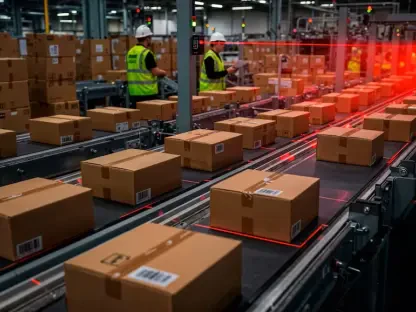The global air freight market is experiencing a significant transformation driven by technological advancements and the e-commerce boom. This article delves into the key insights from a comprehensive study by HTF MI Research, emphasizing growth drivers, market trends, major challenges, and the strategic implications for industry players. Understanding these dynamics is crucial for managers, analysts, industry experts, and other stakeholders looking to gain a competitive edge in a rapidly evolving market landscape.
Technological Innovations in Air Freight
Blockchain Technology for Enhanced Security
Blockchain technology is revolutionizing the air freight industry by ensuring enhanced security and transparency. This decentralized ledger system minimizes risks related to fraud and data breaches, thus boosting the confidence of stakeholders in the supply chain. The integration of blockchain helps in accurate tracking of shipments, thereby reducing delays and discrepancies. This technology also facilitates seamless documentation processes, eliminating the need for extensive paperwork and enabling more efficient customs clearance and parcel verification.
The impact of blockchain extends further into supply chain management, affecting various aspects such as contract management, billing, and auditing. By providing an immutable record of transactions, blockchain improves accountability and trust among trading partners. Furthermore, blockchain’s ability to automate processes via smart contracts helps reduce the overhead and time associated with manual handling, thereby improving overall operational efficiency. As more companies adopt blockchain, it is expected to become a standard feature in air freight logistics, ensuring the secure and efficient movement of goods globally.
IoT and Real-time Tracking
The Internet of Things (IoT) has transformed air freight operations by enabling real-time tracking of cargo. IoT devices installed in aircraft and on cargo containers provide continuous updates on the location, temperature, and condition of shipments. Real-time tracking allows companies to offer better customer service by providing accurate delivery times and promptly addressing any issues during transit. It also helps in optimizing route planning and ensuring the timely delivery of high-value, time-sensitive goods such as electronics and pharmaceuticals.
Aside from improving customer satisfaction, the integration of IoT in air freight brings substantial operational benefits. Companies can monitor the condition of perishable goods, ensuring they remain within specific temperature ranges, thereby reducing spoilages. Additionally, predictive maintenance enabled by IoT sensors on aircraft and ground equipment can foresee potential failures, minimizing downtime and enhancing overall reliability. As the technology becomes more sophisticated, IoT will increasingly drive innovations in air freight, making logistics operations smarter and more efficient.
E-commerce and Cross-border Trade
Growth in E-commerce Driving Demand
The surge in e-commerce activity has significantly fueled the demand for air freight services. Online retail giants and small businesses alike rely on efficient air transportation to meet customer expectations for rapid delivery. With consumers increasingly shopping online for a wider range of products, from electronics to fashion, the need for just-in-time delivery models has become more pronounced. This trend is compelling air freight carriers to enhance their capacity and streamline their logistics operations.
To manage the overwhelming growth in e-commerce, air freight companies are investing in modernizing their fleets and upgrading their infrastructure for better efficiency. Automation in sorting facilities, the use of drones for last-mile delivery, and implementing AI for predictive analytics are among the strategies used to cope with the demand. The shift from traditional retail to online platforms continues to solidify air freight’s role as a critical component in the supply chain, driving the need for faster and more agile logistics solutions that can seamlessly handle surges in demand.
Expansion of Cross-border Trade
The liberalization of global trade policies has opened up new markets and opportunities for air freight companies. Cross-border e-commerce has become a major growth driver as businesses seek to expand their reach beyond domestic markets. Air freight allows for quick and efficient transportation of goods across international borders, accommodating the rising demand for diverse products from global consumers. This expansion necessitates advancements in customs procedures and partnerships with local logistics providers to manage the complexities of international shipping.
Efficient cross-border logistics requires careful coordination and compliance with various international regulations. Companies are increasingly turning to innovative solutions like advanced analytics and blockchain to streamline customs procedures, ensuring faster clearance and delivery times. Additionally, collaborations with local logistics firms facilitate better handling of “last-mile” delivery challenges in foreign markets. As international e-commerce continues to grow, air freight companies that can navigate the complexities of cross-border trade stand to gain a substantial competitive advantage, offering faster, reliable services that meet global consumer expectations.
Environmentally Friendly Practices
Sustainable Logistics Solutions
Environmental sustainability is becoming a critical focus area for the air freight industry. Companies are investing in eco-friendly logistics practices to reduce their carbon footprint and comply with stringent environmental regulations. Innovations such as electric and hybrid aircraft, sustainable aviation fuels, and green logistics hubs are being developed to minimize environmental impact. These practices not only contribute to ecological conservation but also enhance brand reputation and meet the growing demand for sustainable transport solutions.
Companies are actively seeking to cut down carbon emissions by integrating green technologies and investing in renewable energy sources. The development of sustainable aviation fuels (SAFs), which produce significantly fewer emissions compared to traditional jet fuel, is a major step forward. Furthermore, air freight firms are exploring the potential of electric and hybrid aircraft, expected to revolutionize short-haul routes. Implementing these sustainable initiatives not only aligns with regulatory requirements but also appeals to a growing base of environmentally conscious customers.
Delivery Drones and Future Prospects
Delivery drones represent a promising innovation in the pursuit of sustainable and efficient air freight solutions. These unmanned aerial vehicles can reduce traffic congestion and emissions, making them an attractive alternative for last-mile delivery. While regulatory challenges and safety concerns still need to be addressed, the potential of drones to revolutionize urban logistics is undeniable. As technology advances and infrastructure improves, drones are expected to play a significant role in the future of air freight.
The deployment of drones for delivery not only reduces the carbon footprint but also offers a cost-effective solution for urgent and short-distance deliveries. Companies are conducting trials in urban centers and rural areas to better understand the logistical and regulatory challenges involved. Additionally, advancements in drone technology, such as enhanced battery life and payload capacity, are making this mode of delivery increasingly viable. As regulatory frameworks evolve to accommodate drone operations, the future of air freight will likely see larger-scale implementation of drone technology, offering faster and greener delivery options.
Challenges and Market Opportunities
Operational Costs and Compliance
Managing operational costs and adhering to stringent regulatory requirements are major challenges for air freight companies. Fluctuations in fuel prices, labor costs, and airport fees can significantly impact profitability. Compliance with international air transport regulations, customs procedures, and environmental standards requires significant investment in technology and training. Companies that effectively manage these challenges can secure a competitive advantage by offering reliable and compliant services.
To address rising operational costs, air freight companies are employing various strategies such as optimizing flight routes, investing in fuel-efficient aircraft, and leveraging technology for better resource management. Compliance continues to be a moving target as regulations evolve, particularly concerning environmental standards and customs procedures. Investments in staff training and advanced compliance systems are necessary to stay ahead. Mastery of these aspects not only ensures regulatory adherence but also boosts customer trust, ultimately contributing to market leadership.
Specialized Logistics and Niche Markets
The growing demand for specialized logistics services, particularly in the pharmaceutical sector, presents lucrative opportunities. Temperature-controlled shipments and secure handling of sensitive goods are becoming increasingly important, driving innovations in packaging and monitoring technologies. Additionally, niche markets like luxury goods and perishable food items offer significant growth potential. Companies that develop expertise in these areas can cater to specific customer needs and capture a larger market share.
With rising demand for pharmaceutical products, the need for stringent temperature controls and precise tracking has become paramount. Innovations in cold chain logistics and real-time monitoring devices ensure that sensitive products maintain their integrity. Similarly, the market for luxury goods requires specialized handling to guarantee security and timely delivery. Companies that can provide tailored logistic solutions for these niche markets not only diversify their service offerings but also enhance profitability by tapping into high-margin segments.
Regional Insights and Strategic Planning
North America and Europe
North America and Europe remain dominant players in the air freight market, driven by advanced infrastructure, robust e-commerce activity, and high demand for expedited shipping services. Companies in these regions are focused on technological integration and sustainability to maintain their competitive edge. Strategic partnerships, mergers, and acquisitions are common strategies to enhance service offerings and expand market reach. The emphasis on innovation and compliance with stringent environmental and safety standards is critical for growth in these mature markets.
In these regions, companies are continuously looking for ways to upgrade their tech stacks, integrating AI, blockchain, and IoT to streamline operations. The competitive landscape also sees a significant amount of consolidation through mergers and acquisitions, aimed at expanding capabilities and market footprint. Sustainable practices are front and center, with initiatives to reduce emissions and improve energy efficiency becoming key pillars of corporate strategy. Remaining compliant with the ever-evolving regulatory landscape while staying ahead in technological innovation are the keys to sustaining growth in these markets.
Asia-Pacific: A Growing Powerhouse
The global air freight market is undergoing significant changes, propelled by technological advancements and the rise of e-commerce. A detailed study by HTF MI Research offers valuable insights, focusing on the main growth drivers, emerging market trends, notable challenges, and the strategic implications these elements have for industry participants. For managers, analysts, industry experts, and other stakeholders, grasping these dynamics is essential for gaining a competitive advantage in an ever-changing market.
Technological innovations are streamlining operations, reducing costs, and increasing efficiency, which collectively enhance the market’s overall appeal. The surge in e-commerce has further fueled demand for rapid and reliable air freight services, creating numerous opportunities as well as challenges for traditional logistics companies. The study by HTF MI Research underscores the necessity for industry players to adapt and innovate to stay relevant. These transformations are not just fleeting trends; they are reshaping the entire landscape, making it crucial for industry stakeholders to stay informed and agile in their strategies.








